Milling large logs
Other Versions
Spanish
Techniques for sizing down logs too large for the mill. December 22, 2002
Question
I have questions regarding splitting logs larger than the mill will handle. I plan to saw a log in half with a chainsaw this weekend. Having never attempted this before, does anyone wish to offer any advice? How long before the split log halves must be sawed into lumber?
Forum Responses
I would saw it just as soon as possible.
We get some oaks now and then that are too big for the mill. I use a ripping chain on the chainsaw and cut the halves right after they are ripped. It's a lot of work. Makes me wish I had a swing blade or an 066 with a 36" bar.
From contributor A:
Grinding a chain to 5 degrees makes cutting faster. I cut down with my 36 inch bar and then split with dogwood gluts. With 40 inchers, I just cut notches so that the log will sit down on the bed till I can get over it. Tough work, and I too need a swinger.
I did this log earlier in the week. 36 on small end and 43 at butt, 12 ft long and made 605 bdft and 300 was FAS. The man paid me $150 to saw it up for him. A bargain.
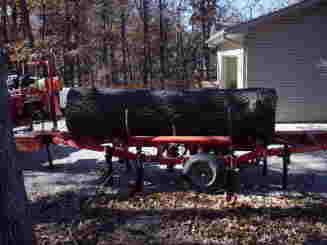
I've done this before. I usually try to stand the log on end (not as hard as it sounds if you have a Bobcat). Then a friend lifts me up in the bucket and I saw downward through the log. My chainsaw is not long enough to cut entirely through the log so I have to make two downward cuts. On a 38" log eight foot long it takes about 45 minutes.
I will be cutting this 12' 40" (small end) red oak log on my Norwood Lumbermate. I think I will either split it down the middle with my Husky 32" saw, cutting from each side, or square two sides down to 30" each way to fit. I would then mill the two cutoffs separately. In the past with these type logs, I have done the latter. This way I can measure up the 30" screw in a straight edge, then use a level on each end to stay in the same plane. I then snap a straight chalk line down each side to make a truer cut as the bar will protrude the other side. I then square a second side to that. This method takes a lot of elbow grease and requires eating a lot of sawdust (not a bad thing if you have the fever). Any suggestions as to making the cut down the middle and staying on course? I would like to make my first attempt at quarter sawing at least half of this Big Red.
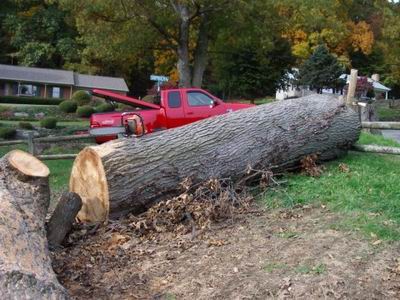
From contributor R:
I split them through the middle to get them on my Lumbermate. The best way to stay on course is to only saw about two inches deep with each pass. You don't have to have a giant saw to get the job done.
I've done it this way many times. Mother Nature knew what she was doing when she made trees (logs) round. I have split logs on the ground only to find out that you have a huge problem moving half a log. They don't roll very well and tend to slam down pretty hard on the mill on that one flat side. Trick is to do the sawing and trimming on the mill. Get the log up there, then trim it to size, unless you have a loader or something to move it. I get them on the mill and look down the mill to see where to trim for the mill to clear, then get up on the log, maybe snap a line if I need help going straight and cut away. Sure, you can do it with a small saw, but be assured that bigger is better. I borrow my bud's 44" bar and it takes a lot of work out of the job. Good luck and remember that unless someone turns the gravity off for you, it's very dangerous to deal with big logs.
From contributor R:
Sometimes there's another reason to take a big log. I took this one a couple weeks ago because it was growing along side the farmhouse I grew up in. The guy that now owns the house decided to have the old farmhouse burned and live in a doublewide mobile home. I dragged it home just because it was a tree I played in as a kid, and it would have ended up burnt. It's going to make a lot of furniture.
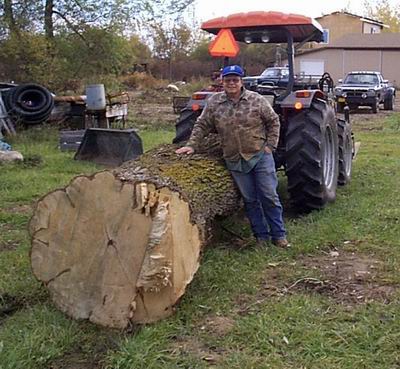
We get a lot of softwood logs that size around here but never hardwoods (and they cut so nice). The biggest hardwood I ever cut was a birch about 19 inches at the fat point.
From the original questioner:
I completed the cut yesterday. My 15 year-old son helped by prying and wedging during the final stages of the cut. He escaped serious injury and only received a minor scrape on his leg. We forgot to turn off the gravity switch.
From contributor R:
Here's another log I got last fall when they cleaned out the ditches on my road.
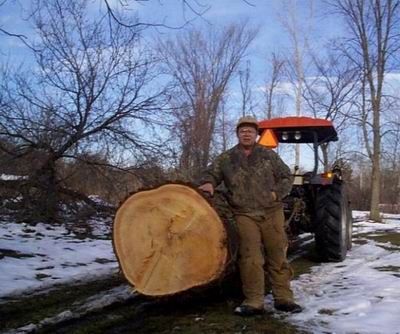
Those are some really nice logs. How many BF did the white pine saw? I am very impressed that you sawed them on your Norwood.
To anyone splitting logs with a chainsaw: Another thing to be very careful of is kickback. The nature of the job requires that the nose of the bar stay in the wood. The deeper the cut, the more vertical the cut, the higher the risk. It can be done, and done safely. The fun all stops when someone goes to the ER. Be safe.
From contributor R:
Because I sell very little lumber I don't keep track of what comes off my mill. I normally just saw what I want when I want it. After having said that, if I remember right, I sawed 880 feet out of that white pine.
When I get a big log like the ones pictured, I almost always quarter saw them. The quarters are still so big I get plenty of lumber, and even though I have a loader to handle logs, it's still easier to deal with quarters rather than halves.
I have way more logs than I need, so sometimes I'm guilty of being a little wasteful. (I do have a woodstove in my shop.)
The only advantage I can see to buying a more expensive mill over my Lumbermate would be to saw faster. Spending money will get you more speed, but my Lumbermate saws just as accurate as the high dollar saws, and it works just fine even when I roll a big log on it!
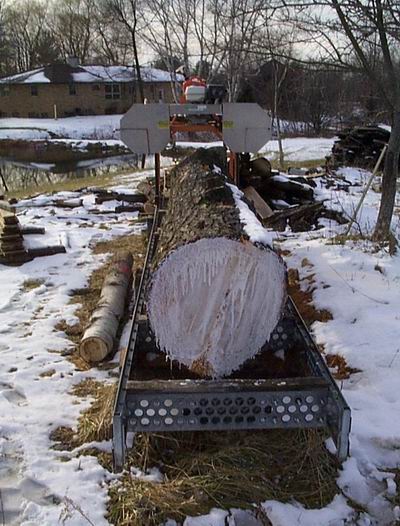
I just finished spanking a 12 foot, 45 inch red oak courtesy of Hurricane Lili. City tree with not a single nail. Went from red to pink as the sun set... Milling a beautiful tree like this is as close to a religious experience as I have ever encountered.
I have a swinger, so size doesn't matter.
From contributor A:
How about this bad boy?
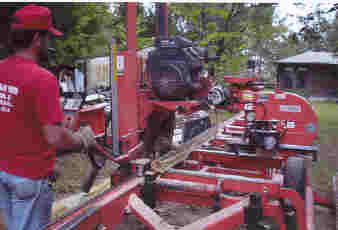
Note his hand on the tiller, just in case that bad boy should get loose from the dogs. Just how did you manage to dog that thing? And why?
From contributor A:
When cutting close like that I keep my hand on the control so I can prevent as much damage as possible. It was a 3-inch red bud log and it produced 3 3/4 x 2 1/2 inch boards 6 ft long. At $40 an hour, I will saw whatever they want. He was very pleased and last time I was there I sawed some dogwood about the same size but they were 1/2 thick. I clamp that with my hydraulics and make the dust fly.
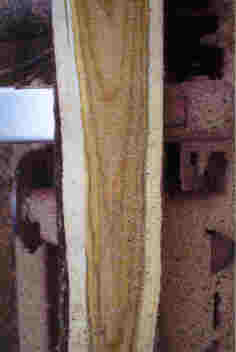
Contributor R, does your Lumbermate have a big steering-wheel-like up/down function? We were talking about up/down functions a couple weeks ago and your mill looks very much like one I'd seen. I know the tracks look like it 100%. The guy using it could turn the wheel about an inch and it looked like the head moved an inch. I used one mill and it was too slow of a ratio for easy operation.
From contributor R:
Yes, my mill does have a steering wheel to raise and lower the carriage. I've not had any problems with it at all, and my mill sits outside all year around. I hope to do something about that, as I do have a sawmill shed in the plans. I want to get my saw mill, edger, and my bigger planer under cover and set up to compliment each other. I hope to get started on that, now that the addition to my shop is about completed.
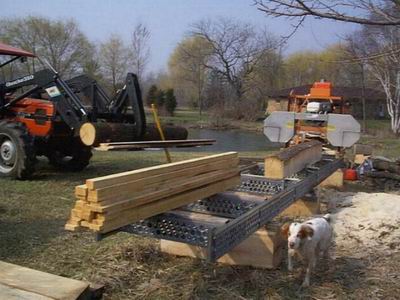
The comments below were added after this Forum discussion was archived as a Knowledge Base article (add your comment).
Comment from contributor J:
I have read the various responses here and am quite surprised. Whenever I get a log too large for my mill, I get a length of detonating rope and usually 2 sticks of dynamite. Then I cut a shallow groove down the log where I want to split it, cut a hole in the ends for the sticks with my chainsaw, then load the log with the sticks and the detonating rope goes in the groove. My log blows in half very easily and I am done in 10 minutes. There is very little loss in terms of wood, maybe 1/2" or so.







